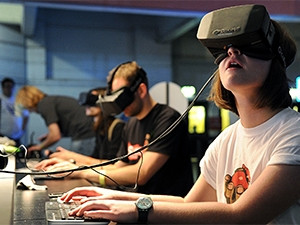
An increasing number of electronics brands are aggressively establishing themselves in the PC gaming hardware market, motivated by the rise of virtual reality (VR) devices, which are expected to generate demand for new and better hardware.
This is according to a new report by TrendForce, which notes the scale of the worldwide market for gaming PCs and their peripherals is projected to reach $24.35 billion this year.
Virtual reality refers to an immersive, computer-generated reality that provides the user an artificial sensory experience. In this artificial world, the user can navigate the 3D simulation, interact with objects, and be immersed completely in that environment.
TrendForce says major device manufacturers are introducing competing virtual reality-ready certifications as they scramble for a piece of the emerging market. It notes gaming constitutes a large and growing source of revenue for major graphics processing unit manufacturers.
Virtual reality company Oculus started shipping its Rift headsets this week, about two years after the company was acquired by social media giant Facebook in a $2 billion deal.
This year, HTC and Sony are also set to launch their virtual reality devices as companies look to offer enhanced gaming and entertainment experiences.
Within the gaming market, TrendForce points out virtual reality technology is an emerging application that has drawn significant development efforts from device vendors.
However, it notes virtual reality requires powerful PCs - the CPU must have the processing power of an Intel i5-4590 or above, the graphic card must have the same or better specs as NVIDIA GeForce GTX 970 or AMD Radeon R9 290, and the minimum RAM is 8GB.
TrendForce says to make purchases easier and avoid device incompatibility, device manufacturers have introduced hardware certifications for PCs that support virtual reality.
Besides initiatives from end-device vendors - HTC and Oculus - chipmakers NVIDIA and Intel have respectively announced GeForce GTX VR Ready and Intel's VR Ready certification plans.
TrendForce believes these different standards on supporting hardware specs reflect the growing rivalry among competitors for influence over the development of the virtual reality market. It notes these certification programmes help accelerate the penetration of virtual reality-capable machines in the PC market.
Gaming PCs will, therefore, see further specs upgrades that can lead to higher prices, TrendForce points out.
Fellow market analyst firm CCS Insights says after years of development, 2.5 million virtual and augmented reality devices are expected to be sold this year, rising to over 24 million device sales in 2018. Analysts estimate more than 12 million virtual reality headsets will be sold in 2017.
"Currently, gaming is the low-hanging fruit for virtual reality devices, but video, entertainment and user-generated content will also drive adoption of this technology," says Ben Wood, CCS Insight's chief of research.
"Most consumers find virtual reality a mind-blowing experience the first time they try it. We believe it has tremendous potential and it's not just about expensive high-end devices such as the Oculus Rift. For only a few dollars, consumers can dip their toe in the water with an inexpensive cardboard holder for a compatible smartphone. We expect this democratisation of the technology to deliver growth not just in affluent mature markets but also in emerging markets where smartphone penetration is stronger than ever."
Share